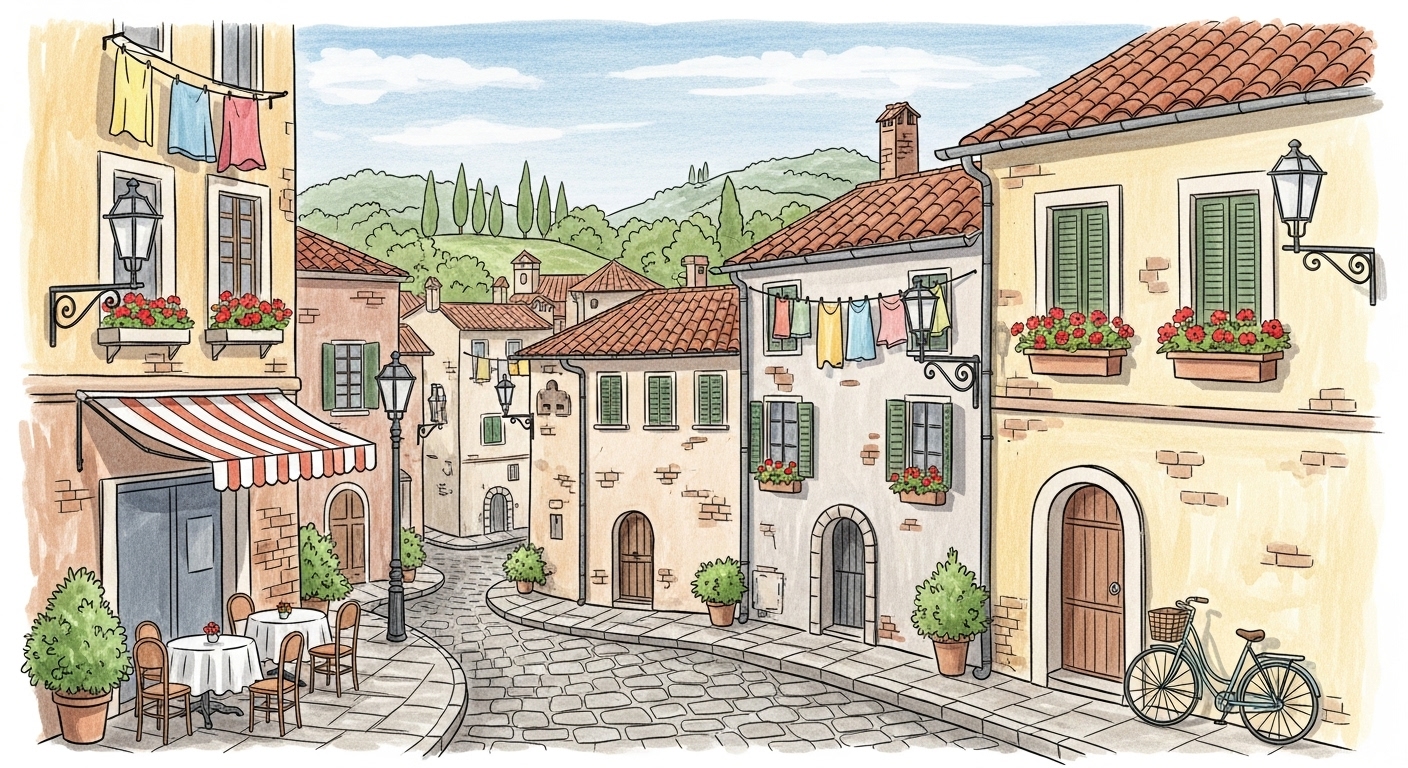The Two Tiny Italian Words That Unlock a New Level of Fluency (`ci` & `ne`)

The Invisible Wall in Your Italian
You’ve done the work. You’ve memorized verb conjugations, your vocabulary is solid, and you can order a cappuccino without breaking a sweat. You can read an article in La Repubblica and get the gist. So why is it that when you try to write or speak, your sentences still feel… clunky? A little too long? A bit like you’re carefully translating from your native language?
It’s a feeling almost every B2 Italian learner knows well. It's the invisible wall between “correct” Italian and “natural” Italian.
Often, the key to breaking through this wall isn’t learning more complex vocabulary or obscure verb tenses. It’s mastering the small, powerful words that natives use instinctively. Today, we’re talking about two of the most important ones: ci and ne.
These tiny pronouns are the secret sauce of Italian fluency. They are like shortcuts that allow speakers to avoid repetition, connect ideas, and make their language flow beautifully. Mastering them is the difference between saying, “Yes, I am going to the cinema tomorrow” and the fluid, native-sounding “Yes, I’m going there.”
This guide will demystify ci and ne. We’ll break down their core functions with clear examples, giving you the mental models to finally understand them. Then, we’ll show you a powerful method to turn this new knowledge into an automatic skill. Andiamo! 🚀
Part 1: The Standalone Guide to ci and ne
Before we do anything else, let’s get the core concepts down. The biggest mistake learners make is trying to find a single, direct English translation for these words. It doesn’t exist. Instead, you need to learn to recognize the job they are doing in the sentence.
Demystifying ci: The Swiss Army Knife of Pronouns 🛠️
Ci is incredibly versatile. It can replace a place, an entire concept, or refer to people. Let's look at its three main jobs.
Job #1: ci as “us” (Direct & Indirect Object)
This is the most straightforward use and the one you likely learned first. It’s the plural version of mi (me) and ti (you).
Direct Object (answers “who?” or “what?”):
Marco **ci** vede.(Marco sees us.)La professoressa **ci** ha chiamato.(The professor called us.)
Indirect Object (answers “to whom?”):
Il cameriere **ci** porta il menu.(The waiter brings the menu to us.)Laura **ci** ha detto la verità.(Laura told the truth to us.)
Easy enough, right? This part is rarely the problem for B2 learners. The real confusion starts with its other roles.
Job #2: ci as “there” (Replacing a Location)
This is arguably the most common and important use of ci you need to master. Ci can replace a previously mentioned location, usually one introduced by prepositions like a, in, su, or da.
Think of it as a way to avoid repeating the name of a place. It’s the difference between sounding robotic and sounding natural.
- Instead of:
Vai a Roma spesso?-Sì, vado a Roma spesso.(Do you go to Rome often? Yes, I go to Rome often.) - A native says:
Vai a Roma spesso?-Sì, **ci** vado spesso.(Yes, I go there often.)
Let’s see more examples:
Sei mai stato **in Sicilia**?->No, non **ci** sono mai stato.(Have you ever been to Sicily? No, I’ve never been there.)Cosa c'è **sul tavolo**?->**Ci** sono i miei libri.(What is on the table? My books are there.)Quando vai **dal medico**?->**Ci** vado domani.(When are you going to the doctor's? I'm going there tomorrow.)
The Mental Shift: Start listening for this! Whenever you hear ci with a verb of motion (andare, essere, venire, tornare), your brain should immediately think, “Aha! That ci means ‘there’.”
Job #3: ci as “about it / on it” (Replacing a Concept)
This is the most abstract and often trickiest use. Ci can replace an entire idea or phrase, usually one introduced by prepositions like a, in, su, or con. It refers back to a previously mentioned topic or argument.
Pensi **al tuo futuro**?->Sì, **ci** penso spesso.(Are you thinking about your future? Yes, I think about it often.) - Here,cireplacesal tuo futuro.Credi **agli oroscopi**?->No, non **ci** credo.(Do you believe in horoscopes? No, I don't believe in them.) -cireplacesagli oroscopi.Scommetto che non riesci a farlo.->**Ci** scommetto!(I bet you can’t do it. -> I bet on it!) -cireplaces the idea of you being able to do it.Conto **sul tuo aiuto**.->Certo, puoi contar**ci**!(I'm counting on your help. -> Of course, you can count on it!) -cireplacessul tuo aiuto.
This is peak fluency. Using ci this way shows you’re not just translating words; you’re understanding and manipulating Italian sentence structures like a native.
Demystifying ne: The Pronoun of Quantity and Origin 🍇
If ci is the Swiss Army knife, ne is a specialized tool. It almost always relates to two concepts: a part of a whole (quantity) or movement away from something (origin). It typically replaces phrases introduced by di or da.
Job #1: ne as “of it / of them” (The Partitive)
This is the bread and butter of ne. You use it when you're talking about a specific quantity of a larger group. It replaces di + [noun].
- Instead of:
Vuoi delle fragole?->Sì, voglio due etti di fragole.(Do you want some strawberries? Yes, I want two hundred grams of strawberries.) - A native says:
Vuoi delle fragole?->Sì, **ne** voglio due etti.(Yes, I want two hundred grams of them.)
More examples:
Quanti fratelli hai?->**Ne** ho due.(How many brothers do you have? I have two of them.)Hai bisogno di soldi?->Sì, **ne** ho bisogno.(Do you need money? Yes, I have need of it.)
⚠️ The Past Participle Rule: This is a critical detail B2 learners often miss. When ne is used with a compound tense (like passato prossimo) and refers to a specific quantity, the past participle must agree in gender and number with the noun ne is replacing!
Quante mele hai mangiato?->**Ne** ho mangiat**e** due.(Becausemeleis feminine plural.)Quanti libri hai letto?->**Ne** ho lett**i** tre.(Becauselibriis masculine plural.)Quanta pasta hai mangiato?->**Ne** ho mangiat**a** molta.(Becausepastais feminine singular.)
If the quantity is zero or unspecified, the participle usually stays in the default -o form.
Hai visto dei film di Fellini?->Sì, **ne** ho vist**o** alcuni.(unspecified) /No, non **ne** ho vist**o** nessuno.(zero)
Job #2: ne as “from there / about it” (Origin or Topic)
Similar to ci, ne can replace a location, but specifically when indicating movement away from it. It replaces da + [place].
Sei appena tornato **dal cinema**?->Sì, **ne** sono appena tornato.(Did you just get back from the cinema? Yes, I just got back from there.)Quando esci **dall'ufficio**?->**Ne** esco alle sei.(When do you leave the office? I leave from there at six.)
It can also replace a topic of discussion, usually introduced with di + [topic].
Parliamo **di politica**?->No, non voglio parlar**ne**.(Shall we talk about politics? No, I don't want to talk about it.)Cosa pensi **di questo problema**?->Cosa **ne** pensi?(What do you think about this problem? -> What do you think about it?)
This last one, Cosa ne pensi?, is a golden phrase. Using it will instantly make you sound more fluent.
Part 2: How to Go From Knowing the Rules to Owning the Skill
Okay, take a deep breath. You now understand the theory. You can see the patterns. But how do you make it an automatic reflex instead of a slow, conscious calculation every time you write a sentence?
You can’t master ci and ne by staring at grammar charts. You master them through a cycle of contextual input and active production with feedback.
Reading a rule is step one. Seeing that rule used a hundred times in real stories is step two. Trying to use it yourself and getting corrected is step three. This cycle is the fastest path to fluency, but it can be hard to create on your own. Finding the right reading material and a patient tutor for instant feedback is a huge challenge.
This is where technology can be a game-changer.
The Modern Way to Master Italian Nuances
Imagine a tool designed specifically to accelerate this learning cycle. That’s the idea behind our app, Toritark. It’s built to solve this exact B2-level problem: turning passive knowledge into active, confident skill.
Here’s how it helps you master tricky concepts like ci and ne:
1. Create Your Own Perfect Lessons (AI Story Generation)
Instead of searching for random articles that might contain ci and ne, you can command our AI to create the perfect practice material. Want to practice ne with quantities? Generate a one-tap story about “A trip to a local market in Naples.” Want to master ci as a location? Create a story about “Planning a weekend trip to Florence.” You get an endless supply of unique, level-appropriate content packed with the exact grammar you need to practice. 📖
2. Learn in Context, Never Lose Your Flow (Interactive Reading)
As you read your custom-generated story, you'll see ci and ne used naturally. If you read a sentence like Quanti cannoli hai preso? Ne ho presi tre, and you're unsure, just long-press the sentence for an instant translation. You see the pattern in a real context, which is 100x more effective than a sterile textbook example.
3. The Ultimate Test: From Reader to Writer (Story Retelling & AI Feedback)
This is where the real learning happens. After you read the story, Toritark prompts you to retell it in your own words. This forces you to move from passive recognition to active production. You have to try and use ci and ne yourself.
And here’s the magic: When you submit your text, our AI gives you instantaneous, granular feedback.
- Let’s say you wrote:
È andato a Milano la scorsa settimana. Lui ama Milano. - The AI won't just say
Finally, Speak with Confidence
📖 Read short stories adapted to your level.
✍️ Retell them & get instant AI corrections on your writing.
🧠 Master new words in their real context.
Similar posts

From Clunky to Classico: A B2 Learner’s Guide to Elegant Italian Writing
Stuck at the B2 level? Your Italian writing might be grammatically correct but lacks native flair. Learn our C.A.S.A. method to write with elegance and sophistication.

The 'Fare' & 'Andare' Crutch: An Italian Learner's Guide to More Expressive Verbs
Tired of your Italian sounding repetitive? Learn why overusing verbs like 'fare' and 'andare' is holding you back and discover a method to upgrade your vocabulary for more sophisticated expression.

The Two ‘Secret Agent’ Words of Italian Your A2 Course Forgot (`ci` & `ne`)
Struggling with `ci` and `ne`? Discover why these tiny Italian words are your key to sounding natural and learn a method to finally master them through active practice.

The Italian Writing Paradox: You Know the Words, But Can't Write the Sentences. Here’s the Fix.
Stuck at the A2 level where you can read Italian but writing feels impossible? Discover a simple 4-step method to activate your passive vocabulary and start writing today.

The Secret to Fluid Italian: Mastering Connectors Beyond 'E' and 'Ma'
Tired of choppy sentences? Discover the essential Italian connectors (connettivi) that will transform your writing and speaking from basic to beautifully coherent.